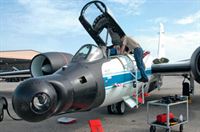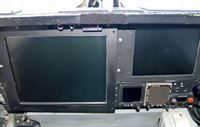Фотографии
-
Регистрационный номер: N926NA [4] NASA's WB-57Fs are being kept busy thanks to their ability to carry heavy payloads to high altitude. This has led them to be deployed to various places around the world. N926NA is pictured making a stop at Lajes in the Azores.
Самолёты на фотографии: Martin RB-57F - США - 1963
-
The converted bomb bay of a WB-57F, which has been adapted to carry pallets. This modification has proved to be one of the most useful because of the versatility it allows in carrying a wide range of payloads.
Самолёты на фотографии: Martin RB-57F - США - 1963
-
An annotated image of the positions on the WB-57F where stores can be carried. The inner large wing pods are called superpods and the outer ones are referred to as spear pods.
Самолёты на фотографии: Martin RB-57F - США - 1963
-
This shot illustrates how low the wings can droop on the WB-57F prior to a flight.
Самолёты на фотографии: Martin RB-57F - США - 1963
-
Регистрационный номер: N926NA [4] An interesting collection of badges below the cockpit of N926NA testifies to the wide variety of units the aircraft has worked with and missions it has performed.
Самолёты на фотографии: Martin RB-57F - США - 1963
-
Регистрационный номер: N926NA [4] WB-57F Project Pilot Scott Reagan and Scientific Equipment Operator Shelley Baccus in front of N926NA.
Самолёты на фотографии: Martin RB-57F - США - 1963
-
Регистрационный номер: N926NA [4] WB-57F N926NA at RAF Mildenhall. NASA WB-57Fs have visited this US Air Force base in the UK several times in recent years either on deployment or as a refuelling stop.
Самолёты на фотографии: Martin RB-57F - США - 1963
-
A close-up of the WAVE camera system nose that was developed to watch for items falling off the Space Shuttle during launch - as happened with a piece of insulating foam that caused damage and led to the loss of Columbia in 2003.
Самолёты на фотографии: Martin RB-57F - США - 1963
-
The modernised front cockpit or the WB-57F.
Самолёты на фотографии: Martin RB-57F - США - 1963
-
For missions involving flying over 50,000ft, the crew wear pressure suits and a helmet.
Самолёты на фотографии: Martin RB-57F - США - 1963
-
The rear cockpit is now dominated by two large screens for the Scientific Equipment Operator to use.
Самолёты на фотографии: Martin RB-57F - США - 1963
-
WB-57F
Самолёты на фотографии: Martin RB-57F - США - 1963
Статьи
- -
- News
- A.Drwiega - Boneyard on Hold for Veteran Sea King /Military/
- A.Spaeth - Hopeful in the Heart of Africa /Commercial/
- C.Kjelgaard - Brazilian Bravura. Embraer's E-Jets Conquer the World /Commercial/
- D.Carrara - Big Wing Beauties. NASA's WB-57Fs. /Technology/
- K.van der Mark - Training the Elite /Military/
- N.Pittaway - Jetstar Group. A Stellar Outlook /Commercial/
- P.Butowski - Russian Supercruiser /Military/
- R.Niccoli - CRUZEX V /Military/











